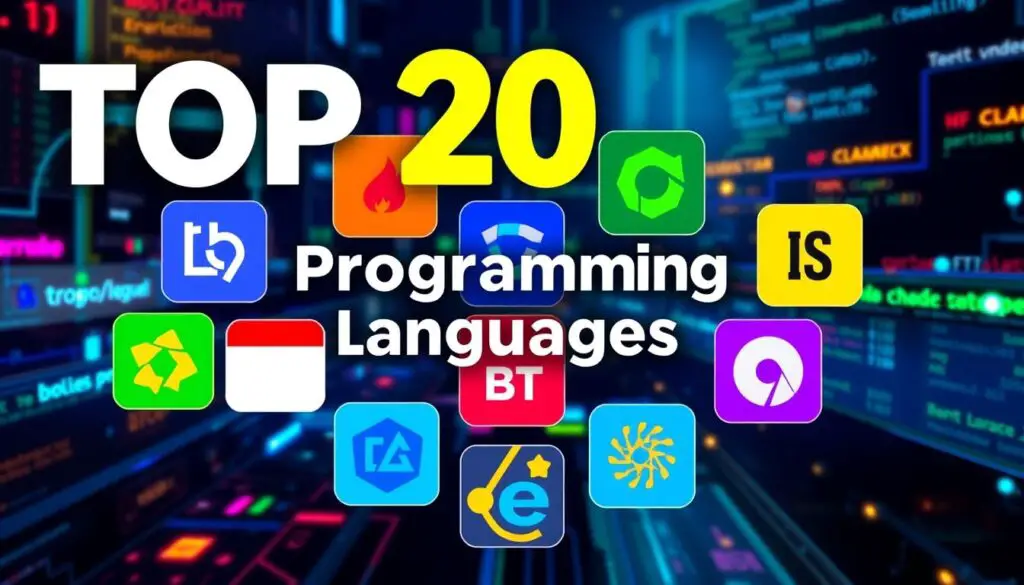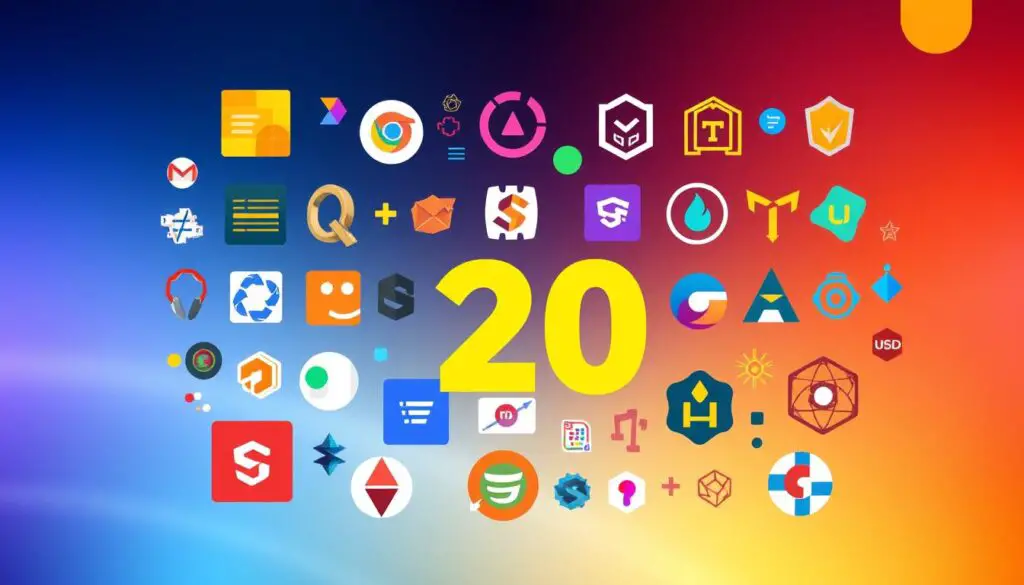In the rapidly evolving world of technology, programming languages have become the foundation for countless digital innovations. This comprehensive guide delves into the top 20 programming languages that are shaping the tech industry in 2023. From the ubiquitous JavaScript to the versatile Python, these languages are essential for aspiring developers and anyone interested in understanding the current landscape of computer programming.
By exploring the strengths, applications, and learning resources for each language, readers will gain valuable insights to help them choose the right programming skills to develop and stay ahead in the rapidly evolving tech landscape. Whether you’re a seasoned programmer or a curious beginner, this essential guide will provide you with the knowledge and tools to navigate the diverse world of top programming languages.
Key Takeaways
- Discover the top 20 programming languages shaping the tech industry in 2023.
- Understand the strengths, applications, and learning resources for each language.
- Gain insights to help you choose the right programming skills to develop and stay ahead.
- Explore the diverse world of top programming languages, whether you’re a seasoned programmer or a curious beginner.
- Leverage the essential guide to navigate the rapidly evolving tech landscape.
Introduction to Programming Languages
In the ever-evolving realm of technology, programming languages constitute the fundamental elements that facilitate software development and propel innovation. These languages, encompassing computer programming basics, coding for beginners, and software development languages, act as the intermediaries between human conception and machine execution. They lay the groundwork for the tech industry trends, enabling the translation of human ideas into actionable code.
What are Programming Languages?
Programming languages are formal constructs, specifically designed to convey instructions to computers. They offer a structured framework for developers to craft code, delineate data structures, and devise algorithms to address particular challenges. Spanning from the rudimentary computer programming basics to the intricate software development languages, each possesses its unique syntax, semantics, and functionalities. This diversity empowers programmers to articulate their concepts in a manner comprehensible and executable by computers.
Why Learn Programming Languages?
Acquiring proficiency in programming languages is a highly beneficial skillset for those aspiring to enter the tech sector. By grasping the foundational principles of coding for beginners, aspiring developers can access a plethora of opportunities. These range from constructing websites and mobile applications to automating processes and data analysis. Moreover, mastering multiple software development languages can significantly bolster one’s problem-solving acumen, logical reasoning, and adaptability. These attributes are highly prized within the tech industry trends.
“The future belongs to those who can write code.” – Unknown
Whether you are a novice in coding for beginners or a seasoned programmer, delving into the realm of programming languages can unveil a multitude of promising and fulfilling career paths within the rapidly advancing tech industry.

Top 20 Programming Languages
In the realm of technology, the selection of programming languages significantly influences software development and innovation. The top 20 programming languages form the bedrock for creating cutting-edge solutions across multiple sectors. These languages are pivotal, serving as both established pillars and emerging forces in the technological landscape.
The popular coding languages cater to the needs of both seasoned developers and newcomers. They act as gateways for aspiring programmers, guiding them through their initial forays into coding. The most used programming languages showcase a diverse spectrum, each with its unique appeal and widespread adoption.
- Python: Renowned for its simplicity and readability, Python has emerged as a leading choice for data science, machine learning, and web development.
- JavaScript: Having transcended its origins in web browsers, JavaScript now underpins server-side applications, mobile development, and artificial intelligence.
- Java: Esteemed for its robustness and cross-platform compatibility, Java remains a cornerstone for enterprise applications, Android development, and big data processing.
- C++: Combining the essence of low-level programming with object-oriented principles, C++ is a cornerstone in game development, system programming, and high-performance applications.
- C#: Within the .NET framework, C# has established itself as a premier language for game development, desktop applications, and enterprise software.
These examples represent a fraction of the top 20 programming languages that are currently defining the technological horizon. As the industry progresses, the importance and demand for these best programming languages to learn are anticipated to persist, positioning them as indispensable assets for both novice and seasoned programmers.
“The language you use to write a program can make a big difference in the system’s efficiency, reliability, and development time.” – Bjarne Stroustrup, inventor of C++

JavaScript: The Language of the Web
JavaScript, a dynamic programming language, has emerged as the bedrock of contemporary web development. Its role as the primary engine behind the majority of web applications solidifies its importance in the tech sector. It facilitates the creation of dynamic websites, enables server-side scripting, and supports mobile app development, cementing its status as the quintessential language of the web.
Applications of JavaScript
JavaScript’s adaptability is evident through its extensive applications in the tech industry. Web developers employ it to introduce interactive features, such as drop-down menus, image sliders, and form validations, to their websites. Moreover, it is utilized for server-side scripting with frameworks like Node.js. Furthermore, its utility extends to mobile app development, powering hybrid apps through technologies like React Native and NativeScript.
Learning Resources for JavaScript
Acquiring proficiency in JavaScript has become a highly coveted skill within the tech industry. Aspiring developers and professionals aiming to refine their skills can access a plethora of learning resources online and offline. From free online tutorials and coding challenges to comprehensive courses and certification programs, numerous avenues exist for delving into JavaScript. Platforms such as freeCodeCamp, Codecademy, and Udemy offer interactive learning experiences, while books like JavaScript: The Definitive Guide and You Don’t Know JS provide in-depth knowledge for advanced learners.
“JavaScript is the language of the web. It’s the only language that can run in all the major web browsers today. It’s also incredibly versatile, with many libraries and frameworks that allow you to build anything from simple websites to complex web applications.”
The tech industry’s ongoing evolution underscores the persistent demand for JavaScript expertise. By embracing the language’s versatility and leveraging the abundant learning resources available, developers can position themselves as indispensable assets in the dynamic realm of web development and programming.
Python: The Swiss Army Knife of Programming
In the realm of programming languages, Python emerges as a multifaceted and potent instrument, indispensable in the tech sector. This high-level, interpreted language has garnered widespread acclaim among developers, data scientists, and machine learning aficionados, solidifying its status as the “Swiss Army knife” of programming.
Python’s versatility is its paramount asset. It excels in a multitude of domains, from web development and data analysis to artificial intelligence and scientific computing. Its straightforward and legible syntax, complemented by an extensive array of libraries and frameworks, renders it a preferred option for novices and seasoned programmers alike.
- Python’s prominence in the data science and machine learning arenas is uncontestable. Its libraries, such as NumPy, Pandas, and TensorFlow, offer formidable tools for data manipulation, analysis, and model training.
- In the tech industry trends, Python’s ascendance is unwavering. Its adaptability and simplicity have cemented its status as a primary language for diverse applications, spanning web development with frameworks like Django and Flask to automation and scripting.
- As a programming language, Python’s simplicity and clarity make it an ideal choice for newcomers, while its depth and versatility also captivate seasoned developers. Its comprehensive library support and vibrant community guarantee solutions for nearly every programming conundrum.
“Python is a language that lets you work quickly and integrate systems more effectively.” – Guido van Rossum, Creator of Python
Regardless of your level of experience in coding, Python’s versatility and increasing significance in the tech industry render it a language worthy of exploration and proficiency. As industry demands continue to evolve, Python’s capacity to adapt and excel across a broad spectrum of applications cements its role as a crucial programming language for the future.
Java: The Foundation of Enterprise Applications
Java, a programming language distinguished by its versatility and robustness, has established itself as the cornerstone of enterprise software development. Its reputation for reliability, scalability, and cross-platform compatibility has solidified its position as the preferred choice for crafting critical applications across diverse sectors. These include finance, healthcare, and e-commerce, among others.
Java’s Role in Android Development
In the mobile app domain, Java has also made a notable impact. It serves as the primary language for Android app development, facilitating the creation of a broad spectrum of innovative, feature-rich mobile applications. These applications meet the dynamic needs of smartphone users, thanks to Java’s extensive libraries, powerful tools, and robust community support. This has cemented Java’s role as a crucial component of the Android development ecosystem.
Java Frameworks and Libraries
The tech industry’s recognition of Java’s value is partly due to its extensive framework and library ecosystem. This includes the widely used Spring Framework for web application development and the powerful Apache Hadoop for big data processing. Java’s ecosystem provides a wealth of tools and resources, empowering developers to craft applications that are robust, scalable, and feature-rich. These frameworks and libraries not only boost developer productivity but also ensure the seamless integration of various components. This results in more efficient and reliable software solutions.






